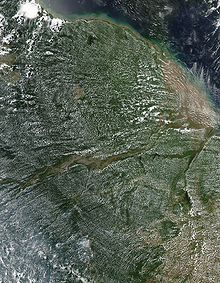Transpiracja
Transpiracja – czynne parowanie wody z nadziemnych części roślin przez: aparaty szparkowe (transpiracja szparkowa), skórkę (transpiracja kutykularna) i przetchlinki (transpiracja przetchlinkowa).
Transpiracja szparkowa stanowi około 75-90%[1] transpiracji ogólnej, natomiast kutykularna nie przekracza kilku procent, przy czym u drzew i roślin cieniolubnych udział transpiracji przez kutykulę jest większy niż u roślin światłolubnych. Aż 97% zaabsorbowanej przez roślinę wody tracona jest przez gutację i transpirację[2].
Czynnikami wpływającymi na szybkość transpiracji są:
- wilgotność powietrza (odwrotnie proporcjonalna)
- ciśnienie atmosferyczne (odwrotnie proporcjonalna)
- temperatura (wprost proporcjonalna)
- wielkość powierzchni parującej[1]
- światło
Transpiracja ma podstawowe znaczenie w przewodzeniu wody przez tkanki roślinne, obniża też temperaturę rośliny chroniąc ją przed przegrzaniem. Potrzeby wodne rośliny charakteryzuje współczynnik transpiracji.
Transpiracja jest procesem fizjologicznym. Ubytek wody z powierzchni roślin jest uzupełniany przez nią za pomocą systemu korzeniowego, kontaktującego się z wodą zawartą w glebie.
Rośliny występujące w klimacie pustynnym wykształciły skuteczny system ochrony przed utratą wody. Przeprowadzają fotosyntezę CAM.
Transpiracja może prowadzić do powstawania chmur nad obszarami leśnymi. Takie chmury noszą wg klasyfikacji Międzynarodowej Organizacji Meteorologicznej nazwę silvagenitus (od łac. silva – las)[4][5].
Zobacz też
Przypisy
- ↑ a b Stanisław Lewak: Fizjologia roślin: Wprowadzenie. Warszawa: PWN, 2009, s. 45. ISBN 978-83-01-15969-6.
- ↑ Rajiv Kumar Sinha: Modern Plant Physiology. CRC Press, 2004. ISBN 978-0-8493-1714-9. [dostęp 2016-03-25]. (ang.)
- ↑ Afternoon Clouds over the Amazon Rainforest (ang.). W: Earth Observatory [on-line]. NASA, 2009-08-26. [dostęp 2017-03-30].
- ↑ Silvagenitus (Section 2.1.3.6.6) (ang.). W: International Cloud Atlas [on-line]. Światowa Organizacja Meteorologiczna. [dostęp 2017-03-30].
- ↑ Poznaj 12 zupełnie nowych chmur. Ich zdjęcia zapierają dech. twojapogoda.pl, 2017-03-24. [dostęp 2017-03-30]. [zarchiwizowane z tego adresu (2017-03-31)].
Media użyte na tej stronie
(c) Rickproser z angielskiej Wikipedii, CC BY-SA 3.0
Some xerophytes will reduce the surface of their leaves during water deficiencies (left). If temperatures are cool enough and water levels are adequate the leaves expand again (right).
This image reveals how the forest and the atmosphere interact to create a uniform layer of “popcorn” clouds one afternoon. During the dry season, the rainforest gets more sunlight. The plants thrive, putting out extra leaves and increasing photosynthesis. The photosynthesising plants release water vapour into the atmosphere. Water vapour is more buoyant than dry air, so it rises and eventually condenses into clouds like the popcorn clouds shown in this image. These clouds are almost certainly a result of transpiration. The clouds are distributed evenly across the forest, but no clouds formed over the Amazon River and its floodplain, where there is no tall canopy of trees. When water vapour condenses, it releases heat into the atmosphere. The heat makes the air even more buoyant, and it rises. The higher it rises, the more the air expands and cools, which allows more water vapour to condense. Eventually, thunderstorms can form. The more concentrated clusters of clouds in the image are likely thunderstorms.



